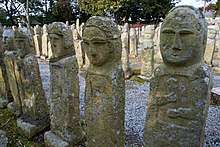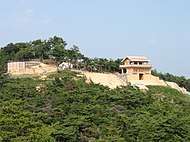Kingdom of Kibi
Kibi (吉備国, Kibi no kuni) was a kingdom of fourth century Western Japan. The Kingdom of Kibi covered most of what is today Okayama Prefecture. Today, the Kibi Road crosses the plain between Okayama and Soja, what was once the heartland of Kibi-no-kuni.

Etymology
In modern Japanese, 黍 kibi refers to proso millet (Panicum miliaceum). However, the name of the kingdom of Kibi, which appears in the Kojiki and the Nihon Shoki (the oldest written records in Japan), may have a different origin that has been lost to time. The Chinese characters used for writing the name of the kingdom, which have been in use for over 1200 years, literally mean "lucky, propitious, good" and "to prepare, preparation; ready; complete, perfect; provision, equipment, installation, facility" and probably have been used for their phonetic values.
Legendary Kibi

Kibi has often been associated with non-Japanese people. One of the main reasons is that the early Japanese mention Kibi as being different to the Yamato-Japanese and practicing “non-Yamato” traditions. Cultural artifacts of the Kibi, like the many Balbals (Kasai rakan statues) found it its area, resemble more Caucasoid traits (like deep set eyes or higher nose bridges) than Mongoloid traits. According to one theory, the Kibi were of Scythian origin, from West Eurasia.[1]
Additionally Kibi has also been associated with the legends of Kibitsuhiko-no-mikoto. According to the Nihon Shoki, he was the son of Emperor Kōrei.[2] Legend says this prince slayed an ogre called Ura, which may be the demonization of the Kingdom of Kibi, destroyed during the reign of Kōrei-Tennō. The “ogre Ura” lived in the Ki castle, the capital of Kibi.
Historical Kibi
Archaeological research of many temples and shrine ruins, as well as burial mounds, suggests that the ancient kingdom was possibly as developed and powerful as the Yamato administration that controlled Japan in the eighth century. The center of power of the Kibi Kingdom was located on the Kibi plain between Soja and Okayama.
References
- Riddle, Mark; Mair, Victor (2011). "Turkic "balbal" in Japan" (PDF). Sino-Platonic Papers.
- Louis-Frédéric, "Kibitsu-hiko no Mikoto" in Japan Encyclopedia, p. 513.
- Gorman, Michael S.F. (1999). The Quest for Kibi. Orchid Press. ISBN 974-8299-23-6.
- Brown, Delmer (1993). The Cambridge History of Japan 6 Volume Set: The Cambridge History of Japan: Volume 1. Cambridge University Press. ISBN 978-0-521-22352-2.
